
Madonna and Child in Glory over the City of Bologna is a c.1593 oil on canvas painting by Annibale Carracci, also known as The Virgin and Child in the Clouds or the Madonna of Bologna. It is now in Christ Church Picture Gallery in Oxford.

Madonna and Child in Glory over the City of Bologna is a c.1593 oil on canvas painting by Annibale Carracci, also known as The Virgin and Child in the Clouds or the Madonna of Bologna. It is now in Christ Church Picture Gallery in Oxford.

It is unanimously identified with the work seen in the private chapel at Palazzo Caprara in Bologna by Giovanni Pietro Bellori and entitled "Madonna [and Child] in Glory with Angels over the City of Bologna seen in the distance" in his 1672 Vite dei Pittori, Scultori ed Architetti Moderni. [1] The Caprara family was powerful and active in politics, producing several noted soldiers, which probably explains the clear civic symbolism of the work, almost certainly commissioned by them. [2] Its dating is solely on stylistic grounds, with no documents surviving as to its commissioning and no date painted onto the work itself.
Influenced by Correggio and Venetian painters like the same artist's 1593 Madonna and Child with Saints , [3] its composition is similar to Madonna of the Earthquake, a Francesco Francia work commissioned by the city of Bologna just under fifty years earlier as an ex voto for ending a series of earthquakes that had terrorised the city's inhabitants in 1505. [4] Its balanced composition also suggests influence from Renaissance artists from Florence and the rest of central Italy [3] and from works by Raphael such as his Ezekiel's Vision , which was for a long time in Bologna - the proportions of the vision's foreground and the far-off bird's eye background landscape both seem to have been a strong influence on the centre of the work now in Oxford. [2]
A smaller version of the work on card was re-discovered by the American art historian John T. Spike, who published on it in 2002, proposing it was an autograph work by Annibale, possibly a preliminary modello requested by the painting's commissioner for final approval. [5] Alessandro Brogi rejected this as an autograph work, but on its exhibition at a Sassoferrato exhibition in 2009 Massimo Pulini accepted Spike's attribution. [6] Two preparatory drawings survive in the Albertina, Vienna and two in the Devonshire Collection at Chatsworth House in the UK, [1] though all four differ from the final painted composition.
It is unknown when the work left Italy, but it was already in England by the 17th century, when it was recorded in James Thornhill's collections. It passed through a number of other collections before being bequeathed to its present owner by John Guise in 1765. [7] [1]

Agostino Carracci was an Italian painter, printmaker, tapestry designer, and art teacher. He was, together with his brother, Annibale Carracci, and cousin, Ludovico Carracci, one of the founders of the Accademia degli Incamminati in Bologna. This teaching academy promoted the Carracci emphasized drawing from life. It promoted progressive tendencies in art and was a reaction to the Mannerist distortion of anatomy and space. The academy helped propel painters of the School of Bologna to prominence.

Annibale Carracci was an Italian painter and instructor, active in Bologna and later in Rome. Along with his brother and cousin, Annibale was one of the progenitors, if not founders of a leading strand of the Baroque style, borrowing from styles from both north and south of their native city, and aspiring for a return to classical monumentality, but adding a more vital dynamism. Painters working under Annibale at the gallery of the Palazzo Farnese would be highly influential in Roman painting for decades.

LudovicoCarracci was an Italian, early-Baroque painter, etcher, and printmaker born in Bologna. His works are characterized by a strong mood invoked by broad gestures and flickering light that create spiritual emotion and are credited with reinvigorating Italian art, especially fresco art, which was subsumed with formalistic Mannerism. He died in Bologna in 1619.

Fishing is a painting by Italian artist Annibale Carracci, painted before 1595 and given to Louis XIV by Prince Camillo Pamphili in 1665. It is currently held and exhibited at the Louvre in Paris.
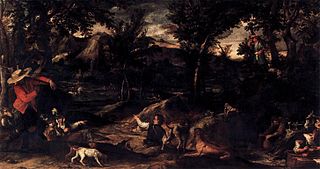
Hunting is a painting by Italian artist Annibale Carracci, painted before 1595 and given to Louis XIV by Prince Camillo Pamphili in 1665. It is currently held and exhibited at the Louvre in Paris.

The Carracci were a Bolognese family of artists that played an instrumental role in bringing forth the Baroque style in painting. Brothers Annibale (1560–1609) and Agostino (1557–1602) along with their cousin Ludovico (1555–1619) worked collaboratively. The Carracci family left their legacy in art theory by starting a school for artists in 1582. The school was called the Accademia degli Incamminati, and its main focus was to oppose and challenge Mannerist artistic practices and principles in order to create a renewed art of naturalism and expressive persuasion.

Pietà is a c. 1600 oil on canvas painting by Annibale Carracci, the earliest surviving work by him on the subject, which was commissioned by Odoardo Farnese. It moved from Rome to Parma to Naples as part of the Farnese collection and is now in the National Museum of Capodimonte in Naples. It is one of many 16th century Bolognese paintings dedicated to the theme of the Pietà, and it is counted among Carracci's masterpieces.

Christ in Glory with Saints and Odoardo Farnese or 'Christ in Glory with Odoardo Farnese and Saints Peter, John the Evangelist, Mary Magdalene, Hermenegild and Edward is a painting by Annibale Carracci. Placed in the Eremo di Camldoli either early in its life or straight after its creation, at the end of the 17th century Ferdinando II de' Medici moved it to the Galleria Palatina in Florence, where it still hangs.
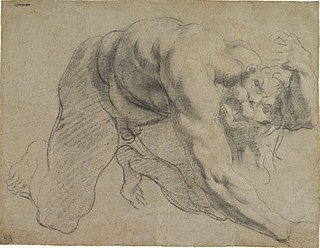
The Palazzo Sampieri frescoes are a set of paintings by Annibale, Agostino and Ludovico Carracci in the Palazzo Sampieri in Bologna. They form the last surviving collection of works by the three artists.
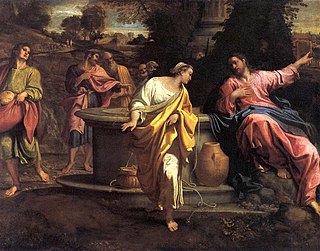
Christ and the Samaritan Woman or The Woman at the Well is a 1593-1594 oil on canvas painting by Annibale Carracci, painted as part of the same scheme as the Palazzo Sampieri frescoes. Several years later he also produced a much smaller autograph copy with variations, now in the Museum of Fine Arts, Budapest.
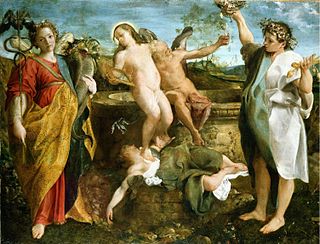
An Allegory of Truth and Time is a 1584–85 oil on canvas painting by Annibale Carracci, now on display in Hampton Court as part of the Royal Collection.

The Baptism of Christ is a painting by Annibale Carracci.

Self-Portrait is a 1593 oil on canvas painting by Annibale Carracci, now in the Galleria Nazionale di Parma. It is dated 17 April 1593 on the top left of the canvas.

Madonna and Child with Saints is a 1588 oil on canvas painting by Annibale Carracci, now in the Gemäldegalerie Alte Meister in Dresden. Signed and dated by the artist, it is also known as Madonna and Child with Saints Francis, Matthew and John the Baptist, Madonna and Child Enthroned with Saint Matthew and the St Matthew Madonna.

Madonna and Child with Saints, Madonna and Child Enthroned with the Infant St John the Baptist, St John the Evangelist and Saint Catherine of Alexandria or the San Giorgio Madonna is a 1593 oil on canvas painting by Annibale Carracci, originally in the Landini chapel in the church of San Giorgio in Poggiale, Bologna. During the 19th century the conservation conditions there worsened and it was moved to the Accademia di Belle Arti for restoration, before being moved to its current home in the then-new Pinacoteca Nazionale di Bologna.. It is signed and dated "ANNI CARR FE MDXCIII".
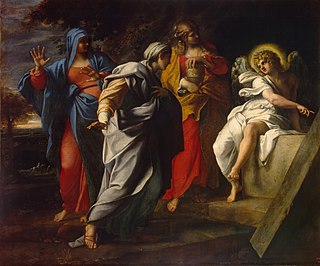
The Three Marys at the Tomb, The Three Marys or The Pious Women at Christ's Tomb is a c.1600 oil on canvas painting by Annibale Carraci, now in the Hermitage Museum in Saint Petersburg, which acquired it in 1836.

Pietà with Saints Clare, Francis and Mary Magdalene is a 1585 oil on canvas painting by Annibale Carracci, now in the Galleria nazionale di Parma.

Venus with a Satyr and Two Cupids or The Bacchante is a 1588-1590 oil on canvas painting by Annibale Carracci, now in the Uffizi in Florence. Its dating is based on its strong Venetian influence - the artist was briefly in the city at the end of the 1580s.

Saint Margaret of Antioch is a 1599 oil on canvas painting by Annibale Carracci, showing Margaret of Antioch. It hangs in Santa Caterina dei Funari church in Rome.

Christ Appearing to Saint Anthony Abbot or The Temptation of Saint Anthony is a 1598-1600 oil on copper painting of Anthony the Great by Annibale Carracci. It was acquired in the 19th century by an English collector and bought in 1846 by the National Gallery, London, where it still hangs.